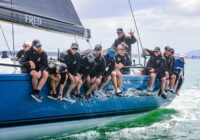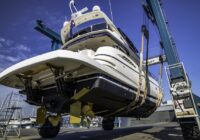News from Marine Safety SA – February 2024
A summer holiday recap from Marine Safety SA
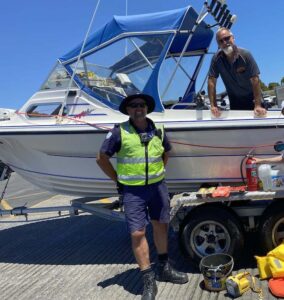
This past December and January, our waterways were bustling with activity, and the Marine Safety SA team was out in full force ensuring everyone’s safety on the water.
With over 1,300 vessel checks across the state, it’s encouraging to report that 63%, of boaters were fully compliant with safety regulations. Although this is a great indicator of the boating community’s commitment to safety; there’s still room for improvement as Marine Safety SA aim to reduce the 37% non-compliance rate.
The school holiday period saw Marine Safety SA officers issuing 149 expiations for various safety violations, a costly reminder of the importance of adhering to safety standards. The team also saw 144 boats turned away at ramps for lacking essential safety gear, 46 vessels instructed to return to shore for corrections, and 7 boats redirected to safer waters to ensure everyone’s well-being. Our team actively addresses safety concerns reported through our report a marine safety concern portal. Through this portal Marine Safety SA have seen reports of jet skis too close to swimmers and speeding near the coast and River Murray crossings. It’s vital for vessel operators to know and follow the rules to keep our waters safe for everyone.
Over the summer holiday period the Marine Safety Officers monitored locations including:
- Adelaide Metropolitan ramps, beaches and waters.
- Fleurieu Peninsula: Wirrina, Victor Harbor and Encounter Bay, Goolwa and the Coorong.
- South East: Robe and Beachport.
- Yorke Peninsula: Port Pirie, Fisherman’s Bay, Port Broughton, Wallaroo, Port Hughes, Port Victoria, Edithburgh, Port Vincent, Black Point, Ardrossan.
- Eyre Peninsula: Venus Bay, Elliston, Coffin Bay, Port Lincoln, Tumby Bay and Cowell.
- River Murray: Murray Bridge, Mannum, Younghusband, Murbko to Morgan and Cadell, Berri and Renmark.
The team will continue to be at boat ramps and on water for the remainder of the boating season with waters expected to be busy again over the Easter period and April school holidays. Remember, safety on the water is everyone’s responsibility, and together, we can ensure a safer boating environment for all South Australians.
South East Field Days – Lucindale
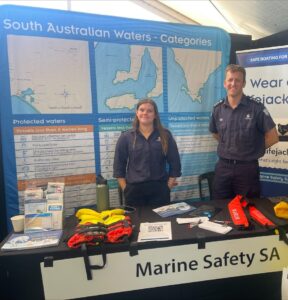
The South East Field Days in Lucindale are only a few weeks away. Why not come and meet the Marine Safety and Compliance team in the Government of South Australia tent over the two days event?
There will be an assortment of stickers on offer for your boat, serving as handy reminders of the necessary safety gear and lifejackets required onboard. Kids participating in the Blue Yakka Trail are encouraged to stop by and say hi to the team and receive a special Marine Safety SA giveaway. The Marine Safety Officers will be on hand throughout the two days to address any questions you have about boating safety. Plus, we’ll showcase one of the Marine Safety SA vessels for you to check out.
Order your Marine Safety SA stickers
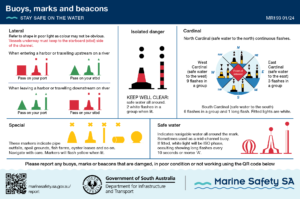
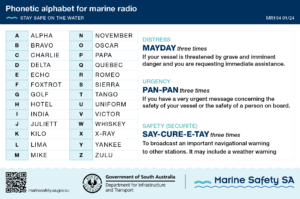
Do you need help with remembering all the different buoys, marks, and beacons you see on the water? Or do you use a marine radio and wish to familiarise yourself with the phonetic alphabet or learn how to signal for help?
Marine Safety SA have got you covered! You can now order Marine Safety SA stickers that can be placed on your vessel, providing you with essential information right when you need it.
Available now:
- Safety equipment checklist – recreational vessels under 8 metres
- Safety equipment checklist – recreational vessels over 8 metres
- QR code to the online safety equipment checking tool
- QR code to the online which lifejacket do you need tool
- QR code to the online report an incident or hazard tool
- QR code to the Marine Safety SA Facebook page
- Buoys, marks and beacons – New
- Phonetic alphabet for marine radio – New
Coming soon:
- VHF marine radio channels
- 27 MHz marine radio channels
To order your free stickers email the Marine Safety SA team at . Please include details of the stickers you would like to order and your postal address.
Knowing the rules on water skiing
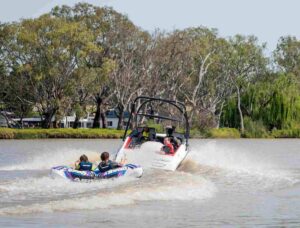
During a recent compliance operation by Marine Safety SA, a jet ski operator was discovered to be under 16, unlicensed, and engaging in the risky activity of towing without an observer on the jet ski. Fortunately, Marine Safety Officers intervened promptly and stopped the unlicensed rider before anything went wrong.
If you operate a jet ski or boat, this serves as a timely reminder to make sure you know the towing rules to help stay safe on the water:
- You must hold a boat licence and be at least 16 years of age to skipper a vessel towing someone.
- Waterskiing boats and jet skis towing people must carry an observer (16 years or older) in addition to the skipper. The observer must continuously watch the skier and give the operator of the boat or jet ski any directions necessary to ensure the safety of the skier.
- A person between 12 and 15 years of age may only act as an observer if they hold a special boat operator’s permit and the skipper is at least 18 years of age.
- You must wear a lifejacket if being towed and may also be required to wear a lifejacket on the vessel.
- You must never tow anyone at night. Waterskiing is not permitted between sunset and sunrise.
- 0.05 blood alcohol limits and drug blood content limit restrictions apply to skippers, observers and skiers.
- A boat must not travel within 100 metres of, or directly behind, a person who is being towed by another boat.
- No more than three people, or one device carrying up to three people, may be towed at one time.
Where can you tow:
- Only tow where you can keep a minimum distance from people in the water, other vessels and structures. For example, in more open and less congested areas.
- Always keep a lookout for floating logs, shoals, snags or other unexpected hazards and structures in the area.
- When towing on coastal waters and inland rivers, be aware of cold water, fast currents and riverbanks.
- In some areas, you must not tow. This may be because of the excessive wash caused by the vessel or nearby hazards. You must follow any signs showing what activities are not allowed.
- Do not tow people under bridges where they could hit pylons. Some bridges have 4 knot speed limits in place while others have rules around where you can pass under the bridge (e.g. At Paringa Bridge you must use the navigational pass under the bridge and travel at a safe speed).
Visit the Marine Safety SA towing and boating webpage for more information.
Does your lifejacket meet Australian Standard 4758?
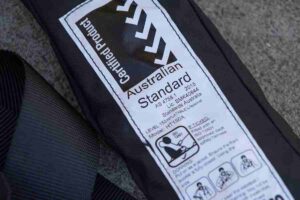
From 1 January 2025 lifejackets that meet older Australian Standards 1512, 1499 and 2260 will no longer be deemed acceptable in South Australia. Instead, lifejackets must meet the current standard Australian Standard 4758.
It’s important to remember that all inflatable lifejackets must undergo servicing according to the manufacturer’s instructions, generally once a year and after every inflation.
You can self-service a lifejacket by following the manufacturer’s instructions or outsource the servicing to a professional service centre or store. Servicing instructions are either supplied with the new lifejacket, printed on the lifejacket itself, or available on the manufacturer’s website.
Locate a service centre near you.
For tips on servicing your lifejacket visit Marine Safety SA
Get your emergency safety equipment ready
Ensuring quick access to safety equipment is crucial in case of emergencies while on the water. Keeping a grab bag or container stocked with essential gear could be a lifesaver if you find yourself in distress and require rescue. It’s important to note that a lifejacket only helps you in an emergency if you are wearing it.
Marine Safety SA strongly advises wearing your lifejacket at all times.
Visit the Marine Safety SA website to learn more about lifejacket wear requirements.
Make sure you have easy access to:
- flares
- emergency position indicating radio beacon (EPIRB) – Marine Safety SA recommends having a registered EPIRB on board. Note: they are not required unless operating more than 3 nautical miles from shore on coastal waters or more than 5 nautical miles from shore in coastal Gulf waters
- marine radio – to make an emergency call for assistance
- mobile phone – but remember your phone may not always work out on the water
- bucket – for bailing out water if needed
- fire extinguisher – to help put out any engine fires.
Watch the video above for a reminder of the essential preparations to make at home before heading out on the water.
Know your flares
Flares are a mandatory safety requirement for boats operating in both semi-protected and unprotected waters. Flares are used as a distress signal to indicate that help is needed and pinpointing your boat’s location for search teams (on water or aerial search). They complement other emergency communications including marine radio, mobile phones (though effectiveness may be limited at sea) and EPIRBS. Activating a registered EPIRB alerts rescuers to your general area, with flares then used to pinpoint your precise location when rescue vessels or aircraft are visible.
Flares should always be stored in a waterproof container and must be replaced before the expiry date printed on the packaging.
Remember that flares contain a small charge and can cause injury if misused so take care when handling and using them; exercise caution when handling and deploying them, and ensure they are kept out of reach of children.
Use the safety equipment checker tool to see what flares you need for the type of vessel you are operating in and where you are operating.
Expired flares need to be handed in at a suitably equipped local police station for safe disposal.







